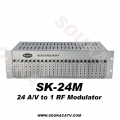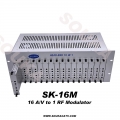
Digitalmodulation in many forms has proven to be an effective means of delivering voice, data, and video through the limited channel bandwidths of modern wireless communications networks.
Simply put, digital modulation has made the modern wireless communications revolution possible. As users of wireless communications devices seek greater capacity to send and receive voice-, data- and video-laden signals, network operators have come to rely on communications standards based on high-capacity digital modulation formats.
HDMI Encoder Modulator,16in1 Digital Headend, HD RF Modulator at Soukacatv.com
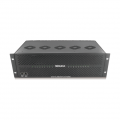
SKD3013 3 Channel HD Encode Modulator
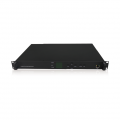
SKD19 Series 1U Rack 12CH Encode Modulator
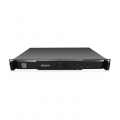
SKD121X Encoding & Multiplexing Modulator
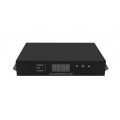
Household Universal Encoding & Modulation Modulator
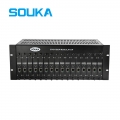
16 IN 1 Digital Modulator Headend System
Modulation of any form relies on controlled changes in one or more of a periodic waveform's three basic parameters: amplitude, frequency, and phase. By changing or modulating a carrier signal in one or more of these parameters, information can be added or modulated to the carrier at the transmit end of a system, then recovered or demodulated at the receive end of the system. Traditional analog forms of modulation relied on simple changes to amplitude, frequency, or phase. But bandwidth is limited, and modern communications systems are required to transport increasing amounts of information over channels with relatively narrow bandwidths.
Just like their analog counterparts, digital modulation formats manipulate the three basic carrier signal parameters, but do so in discrete states representing digital bits. Basic forms of digital modulation include amplitude shift keying (ASK), frequency shift keying (FSK), phase shift keying (PSK), and modulation in which several of the parameters are combined such as quadrature amplitude modulation (QAM), in which at least two discrete phase states and amplitude states are used to transfer information.
Digitally modulated signals are typically generated through use of in-phase (I) and quadrature (Q) rectangular signal coordinates, which can be added to a carrier via a pair of frequency mixers, one of which is 90 deg. offset from the other. Binary phase shift keying (BPSK) is a simple form of digital modulation, keeping amplitude constant but shifting the phase between 0 and 180 deg. In quadrature phase shift keying (QPSK), four phase states are used.
Digital modulation formats are characterized in terms of their symbol rates, or the number of bits that are transmitted per modulation state. In BPSK, for example, one bit per symbol is transmitted. Because the modulation is either at 0 or 180 deg., there is one I signal state and one Q signal state. In QpSK, in which two I and two Q values are transmitted, the modulation format sends two bits per symbol. As a result, QPSK is potentially twice as bandwidth efficient as BPSK. As modulation formats increase in complexity, they can send an increasing amount of data over a given portion of the RF/microwave spectrum. Additional variants of pSK include eight-state PSK (8PSK), 16-state PSK (16PSK), differential PSK (DPSK), differential quadrature PSK (DQPSK), offset quadrature pSK (OQPSK), and p-4 quadrature PSK (p-4-QPSK).
For example, in 16QPSK, there are four I signal states and four Q signal states, so that a total of 4 x 4 or 16 signal states can be transmitted. In this modulation format, four bits per symbol are transmitted; that is, the symbol rate is one quarter the bit rate, making 16QPSK more spectrally efficient than a less complex form of this modulation format (such as simple QPSK, with two bits per symbol).
Varying signals with time, or multiplexing, is also often used with digital modulation formats to achieve efficient use of available frequency spectrum. Typical multiplexing formats include frequency-division multiple access (FDMA), time-division multiple access (TDMA), and code-division multiple access (CDMA).
The symbol rate, also known as the baud rate, determines the amount of bandwidth required by a carrier of a given modulation format. The symbol rate is equal to the bit rate divided by the number of bits transmitted per symbol. For example, a system with bit resolution of 8 b operating at a sampling rate of 1 MHz produces a bit stream of 8 b x 1 mHz = 8 MHz.
With more complex forms of digital modulation come greater linearity and noise requirements in a system, as an increased number of bits and symbols are packed closer together. Sometimes increased transmission power might be needed to keep the symbols of a complex modulation format properly spaced for demodulation.
Established in 2000, the Soukacatv.com main products are modulators both in analog and digital ones, amplifier and combiner. We are the very first one in manufacturing the headend system in China. Our 16 in 1 and 24 in 1 now are the most popular products all over the world.
For more, please access to https://www.soukacatv.com.
CONTACT US
Company: Dingshengwei Electronics Co., Ltd
Address: BldgA, the first industry park of Guanlong, Xili Town, Nanshan, Shenzhen, Guangdong, China
Tel: +86 0755 26909863
Fax: +86 0755 26984949
Mobile: 13410066011
Email: [email protected]
Website: https://www.soukacatv.com
Source: mwrf
